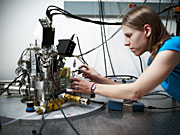- Number 346 |
- September 19, 2011
Magnetic, superconducting material opens new possibilities in electronics

SIMES graduate student
Julie Bert, the paper’s first author,
adjusts imaging equipment used
to make the discovery.
A group of scientists recently sandwiched two non-magnetic materials together and discovered a startling result: The layer where the two materials meet has both magnetic and superconducting regions—two properties that normally can’t co-exist. Technologists have long hoped to find a way to engineer magnetism in this class of materials, called complex oxides, as a first step in developing a potential new form of computing memory for storage and processing.
The discovery, made by researchers at the Stanford Institute for Materials and Energy Science (SIMES), a joint institute of DOE’s SLAC National Accelerator Laboratory and Stanford University, opens “exciting possibilities for engineering new materials and studying the interplay of these normally incompatible states,” said Kathryn A. “Kam” Moler, the SLAC/Stanford researcher who led the imaging studies.
A critical next step: Figuring out whether the superconductivity and magnetism co-exist within the material in an uneasy truce, or whether this marks the discovery of an exotic new form of superconductivity that actively interacts with magnetism. Superconducting materials, which conduct electricity with no resistance and 100 percent efficiency, normally expel any magnetic field that comes near them.
“Our future measurements will indicate whether they’re fighting one another or helping one another,” Moler added.[Janet Rae-Dupree, 650.926.4305,
janetrd@slac.stanford.edu]
